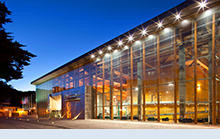 |
European Planetary Science Congress 2014
07 – 12 September 2014
Centro de Congressos do Estoril, Cascais, Portugal |
 |

Paolo Farinella Prize 2014 Awardee
The 4th Farinella Prize for the year 2014 on the topic "non gravitational forces in the Solar System" was awarded to Prof. David Vokrouhlicky (Charles University, Prague, Czech Republic) with the following motivation:
The Board of the 2014 Paolo Farinella Prize, composed by B. Bottke, F. Mignard, A. Rossi, D.J. Scheeres and G.B. Valsecchi, has unanimously awarded Prof. David Vokrouhlicky (Charles University, Prague, Czech Republic) the Prize for 2014, on the topic "non gravitational forces in the Solar System".
David Vokrouhlicky is an accomplished dynamicist who has made major contributions to crucial questions in the dynamics and physics of solar system and has brought new ideas that are now the ground for wider exploration.
A close collaborator and friend of Farinella, David shared Paolo's interest in the dynamics of both artificial and natural celestial bodies exploiting this interdisciplinary approach to enrich both disciplines.
In the 90's their collaboration with the group at the Observatoire de la Cote d'Azur (CERGA) lead to a stream of fundamental papers on non-gravitational perturbations on the geodetic satellite LAGEOS (solar radiation pressure and spin-orbit coupling) whose dynamical modelling is so crucial for the realisation of the Earth reference frame.
These early works on artificial space objects also set the basis for their forthcoming papers on the influence on non-gravitational forces on asteroids opening a whole new understanding on the transport of small bodies in the solar system. David and Paolo Farinella were the first to set forth a unified version of the Yarkovsky effect (the diurnal and seasonal brands) and to draw a bold conclusion at that time regarding the importance of this kind of radiation forces in the orbital evolution of asteroids. At that time when radiation forces were seen relevant only for dust particles, David and Paolo set a new paradigm by showing that these tiny forces could drive minor bodies into the internal region of the solar system and be responsible for triggering their capture into resonances.
This has been largely accepted since and today Yarkovsky (or Yorp) are still hot topics in this community with scores of papers every year dealing with one or several aspects. The linear model he published in 1999 remains the reference for the subject and has been used in other noted papers on the origin of near earth asteroids. David and his collaborators pioneered the role of thermal torque on the spin history of asteroids at a time when collisions were deemed as the main source of evolution.
The contributions of David Vokrouhlicky are very well known in the solar system community and he co-authored in 2006 the review paper on the Yarkovsky and YORP effect. In 2003 and 2007 David co-authored two Science papers on the first direct detection of the Yarkovsky and YORP effects, respectively, in agreement with the theoretical predictions he did in the preceding years.
Last, but not least, it is worth mentioning David's contributions on relativistic gravitational theories, mainly on the issue of the equivalence principle.
The characteristic of the contributions of David is the near perfect balance between highly sophisticated theoretical tools and the applications to physical and testable issues, with more insight than lengthy computations. This is a valuable combination of skills leading to mathematically clean and elegant papers controlled by a secure physical insight.
The textbook "Physics of the Solar System" the he wrote with Bruno Bertotti and Paolo Farinella stands as a comprehensive compendium of the advances in the field and as an evidence of the wide range of his expertises.
Awards Ceremony and Prize Lecture
The Prize will be officially delivered to Prof. David Vokrouhlicky in a special Session at the EPSC2014 on 08 September 2014, during the opening ceremony that will take place from 09:00 to 10:30 a.m. in the Jupiter Room.
At 12:45, in the same room, Prof. Vokrouhlicky will give the Prize Lecture: "Yarkovsky and YORP effects: Paolo's legacy"
